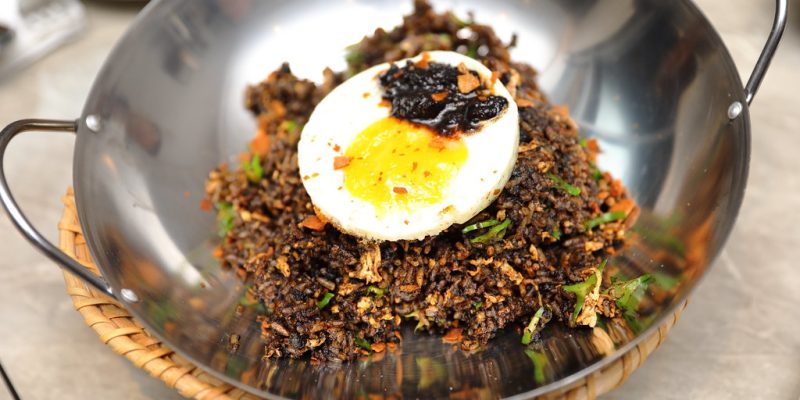Buah Keluak Fried Rice: A Bold Twist on a Peranakan Classic

Buah keluak fried rice is a modern culinary innovation that puts a bold spin on traditional Peranakan flavors. Infused with the deep, earthy aroma of the iconic buah keluak nut, this dish is a celebration of heritage and creativity. While buah keluak is typically used in rich stews like Ayam Buah Keluak, this reimagined version in a fried rice format delivers the same intensity in a convenient, crowd-pleasing dish.
In this article, we’ll explore the history of buah keluak, its unique flavor profile, how it’s incorporated into fried rice, and why this dish is gaining popularity among foodies seeking adventurous yet comforting meals.
What is Buah Keluak? Understanding This Unique Ingredient
Buah keluak (pronounced boo-ah kuh-loo-ahk) is the seed of the Pangium edule tree, native to Southeast Asia. It’s commonly used in Peranakan (Straits Chinese) cuisine, revered for its distinctive, almost truffle-like flavor and jet-black flesh. However, it is naturally toxic when raw due to high hydrogen cyanide content. It undergoes a meticulous fermentation and soaking process to make it safe for consumption — a practice that has been passed down through generations.
Its flavor is bold, nutty, slightly bitter, and complex, often likened to dark chocolate, mushrooms, or olives. Traditionally, it’s mashed into a rich paste and stuffed into chicken or stewed with tamarind and spices.
Now, modern chefs and home cooks are pushing the boundaries, using buah keluak in pasta, burgers, and fried rice — making its intense flavor more accessible and palatable to a wider audience.
The Cultural Significance of Buah Keluak in Peranakan Cuisine
To understand the impact of buah keluak fried rice, one must appreciate its deep cultural roots in Peranakan heritage. The Peranakan community — descendants of Chinese immigrants who settled in the Malay Archipelago — developed a unique culinary style that fused Chinese, Malay, and Indonesian elements.
In traditional dishes like Ayam Buah Keluak, the nut’s black, pungent paste is mixed with minced pork, spices, and tamarind, creating a powerful, savory sauce that permeates every bite. This dish often features during festive occasions, weddings, and family gatherings, symbolizing both culinary complexity and cultural pride.
Buah keluak fried rice is a modern way of preserving and celebrating these traditions, offering a gateway to Peranakan flavors through a more universally loved format — fried rice.
Key Ingredients in Buah Keluak Fried Rice
The star of the dish is, of course, buah keluak paste, but the beauty of fried rice lies in its adaptability. Here are the core ingredients that bring this dish to life:
Essential Ingredients:
- Buah keluak paste – usually mashed from pre-fermented nuts or pre-made from specialty grocers.
- Cooked jasmine rice – preferably a day old for better texture.
- Garlic and shallots – aromatic base to complement the keluak.
- Eggs – for richness and protein.
- Soy sauce and fish sauce – to balance umami and saltiness.
- Chili padi (optional) – for a spicy kick.
- Spring onions and coriander – for freshness and garnish.
Optional Add-ons:
- Shredded chicken, prawns, or mushrooms – protein options for heartier versions.
- Belacan (shrimp paste) – adds a pungent Southeast Asian aroma.
- Lime wedges – to brighten the dish.
The result is a flavorful, umami-packed dish that is earthy, smoky, and savory, with hints of sweetness and spice.
Step-by-Step: How to Make Buah Keluak Fried Rice
Here’s a basic guide to making buah keluak fried rice at home:
Ingredients:
- 2 cups cold cooked rice
- 2 buah keluak nuts (fermented, scooped, and mashed) or 2 tbsp keluak paste
- 2 cloves garlic, minced
- 2 shallots, finely sliced
- 2 eggs
- 1 tbsp soy sauce
- 1 tsp fish sauce
- 1 tbsp cooking oil
- Chili padi (optional)
- Spring onions and coriander (for garnish)
Instructions:
- Heat oil in a wok over medium-high heat.
- Add garlic and shallots, and sauté until fragrant.
- Stir in the buah keluak paste and fry until slightly dry and aromatic.
- Push everything to the side and scramble the eggs in the wok.
- Add the cold rice, breaking it up with a spatula.
- Drizzle soy sauce and fish sauce, and mix thoroughly.
- Toss in chili padi and stir-fry everything together for 2–3 minutes.
- Garnish with spring onions and coriander, and serve hot.
Pro Tip: For extra aroma, stir in a teaspoon of belacan or add crispy shallots on top.
The Flavor Experience: What Does Buah Keluak Fried Rice Taste Like?
Expect a rich, almost smoky umami depth, layered with bitterness, nuttiness, and subtle sweetness. The flavor is distinctive but not overpowering when balanced correctly. Unlike standard fried rice, which leans on soy or oyster sauce for flavor, buah keluak offers a more robust and earthy taste, making it memorable and satisfying.
Those familiar with Ayam Buah Keluak will find the flavors recognizable, while newcomers might compare it to mushroom risotto meets truffle oil fried rice.
Its bold character makes it ideal for pairing with pickled vegetables, fried anchovies, or a side of sambal for added contrast.
Health Benefits and Nutritional Notes
Buah keluak is high in iron, protein, and fiber, and when consumed safely (i.e., after fermentation), it can be part of a nutrient-rich diet. Combined with brown rice or protein-rich toppings like tofu or eggs, buah keluak fried rice can be both delicious and nutritious.
Key health notes
- High in antioxidants – thanks to the black, fermented nature of the nut.
- Supports gut health – when prepared with aromatics like garlic and shallots.
- Energy-boosting – especially with rice and egg combo.
However, moderation is key, as the dish can be rich in fats and sodium, particularly when soy sauce or belacan is added.
Buah Keluak in Modern Fusion Cuisine
As part of the broader trend of modernizing heritage cuisine, buah keluak is being reinvented in creative ways:
- Buah Keluak Pasta – using keluak paste as a base for cream sauces.
- Buah Keluak Burgers – mixing the paste into meat patties.
- Vegan Buah Keluak Dishes – using mushrooms, lentils, and tempeh.
- Desserts (yes, really!) – like keluak chocolate cake or keluak gelato, showcasing the nut’s earthy depth.
These adaptations reflect a growing appreciation for Southeast Asian ingredients in fine dining and experimental kitchens. Buah keluak fried rice fits neatly into this trend — staying true to its roots while inviting new palates to explore its depth.
Conclusion
Buah keluak fried rice is more than just a dish — it’s a bold culinary statement. It brings together the ancient, revered flavors of Peranakan cooking with the comfort and versatility of fried rice. Whether you’re a heritage food enthusiast or simply someone eager for bold, earthy flavors, this dish is a must-try fusion of culture and creativity.
Its simplicity in preparation, combined with its rich cultural and taste profile, makes it perfect for home cooks, restaurant menus, and adventurous foodies alike. By turning buah keluak into an everyday staple, we not only preserve its heritage but also give it new life in modern cuisine.
FAQs
1. Is buah keluak safe to eat?
Yes, but only after proper preparation. Raw buah keluak is toxic due to cyanide content. Commercially sold keluak is usually fermented and safe for cooking.
2. Where can I buy buah keluak or keluak paste?
You can find it at specialty Asian or Peranakan grocery stores. Some online retailers offer pre-mashed or paste versions for convenience.
3. What does buah keluak taste like?
It has an earthy, nutty, and slightly bitter flavor, similar to truffles, dark chocolate, or mushrooms.
4. Can I make a vegetarian version of buah keluak fried rice?
Absolutely. Omit fish sauce and add tofu, mushrooms, or tempeh to enhance the umami profile without animal products.
5. How long does buah keluak fried rice keep?
It can be stored in the refrigerator for up to 3 days. Reheat thoroughly in a pan or microwave before serving.
Also read: Otah Bun Delight: A Spicy Southeast Asian Street Food Favorite










